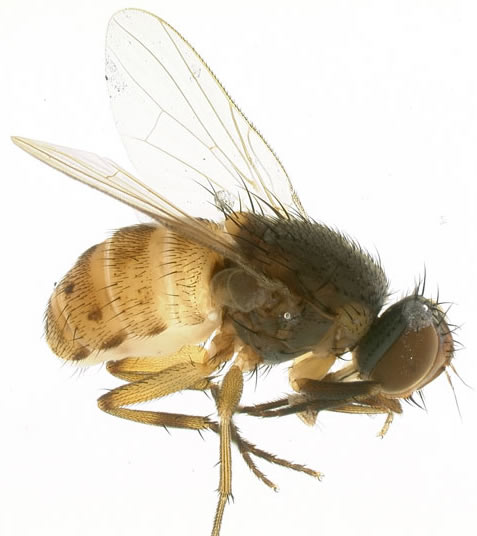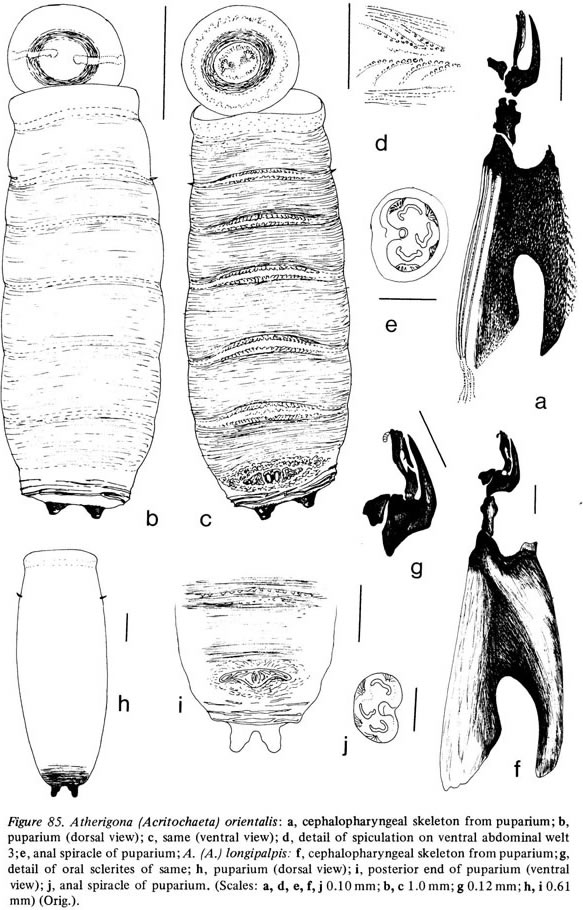common name: pepper fruit fly
scientific name: Atherigona orientalis (Schiner) (Insecta: Diptera: Muscidae)
Introduction - Synonymy - Life History and Description - Distribution - Hosts - Pest Status in Florida - Selected References
Introduction (Back to Top)
Atherigona orientalis (Schiner) is commonly referred to as the pepper fruit fly or tomato fruit fly. Despite its common names, it is not a true fruit fly in the family Tephritidae, but rather a member of the Muscidae, the same family to which the common house fly belongs. The pepper fruit fly is found in most tropical and subtropical areas of the world and is usually considered a secondary pest or “trash fly.” However, it can sometimes be a primary pest of certain agricultural crops, most notably plants in the family Solanaceae. Thus, in a few tropical/subtropical countries where the fly has not been found, such as Guatemala and New Zealand, it is considered a pest of regulatory importance (Biosecurity New Zealand 2011, World Trade Organization 2003).
Figure 1. Adult Atherigona orientalis. Photograph by Gary Steck, Florida Department of Agriculture and Consumer Services, Division of Plant Industry.
Synonymy (Back to Top)
Acritochaeta excisa Thomson
Acritochaeta orientalis (Schiner)
Atherigona excisa var. flavipennis Malloch
Coenosia excisa Thomson
Atherigona magnipalpis Stein
Atherigona trilineata Stein
Acritochaeta pulvinata Grimshaw
Life History and Description (Back to Top)
Eggs are laid in cracks of splitting ripe to rotting fruit, in oviposition sites of other insects and even in carrion or feces, as females do not possess a sharp, strong ovipositor able to puncture hard tissues. The eggs are about 0.9 mm in length and are usually inserted so that one tip is exposed. Eggs hatch in about 12 hours at 85°F, and there are three larval instars that together last about five days. The first and second instar larvae are small and undescribed, but the 3rd and final instar grows to a length of 4-6 mm (Skidmore 1985). The larvae feed on a wide variety of material and can even be carnivores of larvae of other flies. Pupae are unusually short and broad for this group of flies; shiny to matte in appearance, dark orange to dark red in color and enclosed in cocoons. The pupal stage lasts about 6 days at 85°F (Skidmore 1985). Adults are small yellowish-gray flies with a body length of about 4 mm (Olsen 1996). Wing length is 2.5 to 3 mm. The head profile is almost square.
Figure 2. Atherigona orientalis puparium from Skidmore, P. 1985. The Biology of the Muscidae of the World. Page 291, figure 85. Originally published by Dr. W. Junk Publishers, Dordrecht, the Netherlands. Used by kind permission from Springer Science+Business Media B.V.
Distribution (Back to Top)
United States: The fly has been reported from California, Florida, Georgia, Hawaii and Texas (CABI 2000).
Florida: Though this fly may occur throughout Florida, the Division of Plant Industry of the Florida Department of Agriculture and Consumer Services only has definite records from the following counties: Brevard, Broward, Collier, Hillsborough, Indian River, Manatee, Martin, Miami-Dade, Okeechobee, Orange, Osceola, Palm Beach, Pinellas, Polk, Sarasota and St. Lucie.
Hosts (Back to Top)
Worldwide: This fly is highly polyphagous. Larvae feed and develop on live and decaying plant material, feces, carrion and even the live larvae of other insects including the tobacco caterpillar (Spodoptera litura Fabricius). It is known to lay eggs in oviposition sites of other insects and it is suspected that the larvae of Atherigona orientalis feed on the larvae of Bactrocera spp. (Uchida et al. 2006) and Dacus spp. (Skidmore 1985) fruit flies.
Major plant hosts: cabbage and cauliflower (Brassica olicaceae), bell pepper (Capsicum annuum), orange (Citrus sinensis), melon (Cucurbis melo), tomato (Lycopersicon esculentum), beans (Phaseolus spp.) and sorghum (Sorghum bicolor). Ogbalu et al. (2005) reported that Atherigona orientalis is a major primary pest of bell pepper in Nigeria, stating that the fly oviposits on the fruit at the calyx, the grooves, and blossom end. He further indicates that the larvae can cause serious damage to both unripe and ripe fruit of most pepper cultivars in Nigeria. An information kit published by the government of Queensland, Australia lists Atherigona orientalis as a primary pest of tomato because the female fly will lay eggs in the cracks of the fruit and the developing larvae will ruin the fruit (Queensland Government 1998).
Minor plant hosts: onion (Allium cepa), cucumber (Cucumis sativus), carrot (Daucus carota), peach (Prunus persica), aubergine (Solanum melongena), wheat (Triticum aestivum) and maize (Zea mays).
Unusual hosts: human and pig feces, carrion, decaying plant matter, dead insects and the live larvae of Dacus spp. fruit flies. (Skidmore 1985)
Florida: Atherigona orientalis is frequently captured in traps set among plants, but it is not known whether the fly is attracted to the plant or the trap lure. In Florida, the fly has been reared from fruit of the following plants: calamondin (X Citrofortunella microcarpa), grapefruit (Citrus x paradisi), tangerine (Citrus reticulata) Surinam cherry (Eugenia uniflora), Ficus citrifolia, kumquat (Fortunella japonica), creeping cucumber (Melothria pendula), avocado (Persea americana), tropical soda apple (Solanum viarum) and rose apple (Syzygium jambos). (Florida Department of Agriculture and Consumer Services, Division of Plant Industry Entomology Specimen Reports)
Pest Status in Florida (Back to Top)
In contrast to some areas of the world, Atherigona orientalis is seldom a noticeable plant pest in Florida, despite the presence of hosts such as bell pepper and tomato, which can be heavily infested elsewhere. In Florida, Atherigona orientalis appears to be largely restricted to attacking previously damaged fruit, and therefore is not now a pest of major concern.
Selected References (Back to Top)
- Biosecurity New Zealand. (2011). Unwanted Organisms Register. (4 April 2013).
- CAB International. (2000). Data Sheet Appendix 1 pg. 5. (4 April 2013).
- Ogbalu OK, Emelike NJT, Amachree EI, Uche F, Thomas CN. 2005. Characterization and preferred oviposition sites of Atherigona orientalis (Schiner) on Nigerian pepper fruits. Journal of Applied Sciences and Environmental Management 9: 19-23.
- Olsen AR. 1996. Fundamentals of Microanalytical Entomology. 2000. CRC Press, Inc. Boca Raton, Florida
- Queensland Government. (1998). Tomato Information Kit, reprint. (4 April 2013).
- Skidmore P. 1985. The Biology of the Muscidae of the World. Dr. W. Junk Publishers, Dordrecht, the Netherlands.
- Sivannarayana P, Rao AS, Reddy GPV. 1985. Identification of New Parasites on Tobacco Caterpiller (Spodoptera litura Fabricius) Andhra Agricultural Journal 32: 284.
- Uchida GK, Mackey BE, Vargas RI, Beardsley JW, Hardy DE, Goff ML, and Stark JD. 2006. Response of nontarget insects to methyl eugenol, cue-lure, trimedlure and protein bait bucket traps on Kauai Island, Hawaii, USA. Proceedings of the Hawaiian Entomological Society 38: 61-71.
- World Trade Organization. (2003). G/SPS/N/GTM/19. Committee on Sanitary and Phytosanitary Measures. (4 April 2013).

